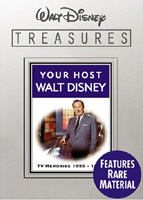 BUY IT AT AMAZON: CLICK HERE!
BUY IT AT AMAZON: CLICK HERE!
STUDIO: Walt Disney Home Video
MSRP: $32.99
RATING: Not rated
RUNNING TIME: 458 minutes
SPECIAL FEATURES:
• “My Dad, Walt Disney”
• “I Captured the King of the Leprechauns”
• Disneyland USA at the Radio City Music Hall
• “Working with Walt”
• Introductions by Leonard Maltin
• Production art galleries
The Pitch
Spend some quality time with Uncle Walt and his fantastic corporate machine.
The Humans
Walt Disney, Leonard Maltin, Annette Funicello
The Nutshell
Not many heads of corporations are willing to put their faces out to the public. Sure, there are some exceptions, but no one today can compare to Walt Disney. Each and every week for over 10 years, Walt stood front and center on television sets across the country. Baring the sly grin of a salesman in love with his product, coupled with an innocent charm, Walt convinced America to dream the Disney way. Your Host Walt Disney showcases programs from 1956 to 1965 that best exemplify Walt’s gifted ability to innovate and entertain, while still brainwashing the masses.
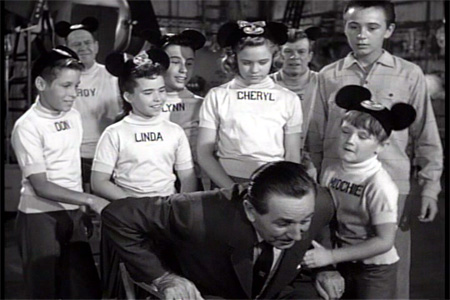
Where do you think you’re going? We ain’t throughs with you yet, tough guy.
The Lowdown
Not many people have had a bigger cultural impact than Walt Disney. The man was able to run a multi-divisional enterprise, yet hold a warm public perception. After viewing Your Host Walt Disney its hard not to think highly of Uncle Walt.
Most all the programs have one thing in common. At their heart, they are promotional pieces for everything Disney. What makes these programs worth watching is how Walt, like a skilled illusionist, erases that thought from the viewers’ mind by producing an entertaining program.
Even the programs without an obvious product to sell are intended to create a connection and loyalty to the Disney name.
"Where the Stories Come From" (1956) is one such program. This episode focuses on the behind the scenes inspiration of Walt and his creative team, when developing films and animated shorts. It explores their private lives, and what sparks their creativity. Disney was smart to manifest a public face or two in all his divisions, whether it was film, animation, television, or theme parks. He even makes a point of mentioning that one of the guys in lighting is retiring. The current thought of the Disney Company is that of a cold-hearted conglomerate. It’s fascinating to watch these old programs knowing that all of Walt’s goodwill eventually will be squandered.

"Mmmmm…gummy Venus de Milo."
Other programs in this set display Walt’s confidence and adoration for his projects. "The Fourth Anniversary Show" (1957) includes previews of upcoming new characters and films. The Mouseketeers give Walt a surprise party where they convince him to make a Road to Oz feature film. In the end, Road to Oz never got off the ground. It’s a ballsy move to advertise a new movie before the details have been finalized. Walt wasn’t afraid to disclose any of his future projects, however uncertain they may be. Judging from this set, Disney was enthusiastic about the future plans of his company, and he genuinely wanted to share that enthusiasm with the public.
Kodak presents "Disneyland 1959" and the "Disneyland Tenth Anniversary Show" (1965) continue to showcase Walt’s child-like enthusiasm for his creations. Disneyland 1959 was a live broadcast of the opening of the Submarine Voyage, Monorail, and Matterhorn. Walt is featured periodically as he travels from each new ride with celebrities and politicians. Throughout the program, Walt is constantly ad-libbing, keeping his adult entourage smiling. There’s a glint in his eye as the Nixon family climbs aboard the monorail. He truly believed in his theme park’s appeal and that jumps out at the viewer while watching this program. Part of the presentation is rather dry, especially the parade. These tedious moments are saved by the inclusion of all of the Kodak commercials from the broadcast. Disney loved nostalgia, and these corny commercials ooze it.
The most entertaining entry in this set is the "Disneyland Tenth Anniversary Show." It’s nothing more than an hour long commercial for Disneyland, but once again Walt’s charisma keeps the cynics in check. Walt is at his most playful in this episode, interacting with Imagineers, while showing off the latest innovations for future attractions. Cutting edge technology that should have stayed hidden are shown off with brazen confidence. Walt believed he was the best around and wasn’t afraid of competition. This sense of bravado was one of the attributes that the American public lapped up. If Walt thought something was amazing than it simply had to be true.
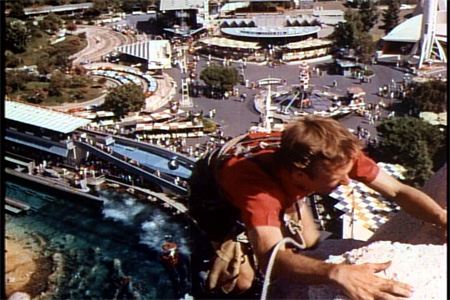
The exciting conclusion to Colin Farrell’s Matterhorn.
"The Backstage Party" (1961) episode seems to be a bit of an odd choice. Walt takes a backseat to most of the hosting duties. Annette Funicello takes over after the first twenty minutes. What follows is a wrap party for Babes in Toyland. What a coincidence that the production’s wrap plays out just like an elaborate advertisement for the film, complete with numerous musical extravaganzas. The episode doesn’t really show off Walt’s unique screen presence, but it does prove that Annette was a fox. Tommy Sands, you lucky bastard.
This set is a fascinating bit of entertainment history. It’s a case study in the proper ways to market a product. As pure entertainment, it stands up quite well. Each of the programs are jam packed with cartoons, musical numbers, and Henry Calvin. (The fat guy from Zorro) Some of the programs have boring sections, but each episode is far more rousing than lackluster. For Disney fans, it’s a must own. For everyone else, I’d recommend taking a look at it just to observe a master storyteller in his element.
The Package
The set comes heavily fortified in a tin case. A certificate of authenticity is included along with a booklet and publicity photo of Walt. Bored of looking at framed pictures of your loved ones? Burn them. You’ve got Uncle Walt to sit on your desk now. The audio and video look great for programs from the late fifties and sixties. It’s obvious that time and care went into the restoration of this material. There are some rough patches in the video, but overall the look and sound is polished. Leonard Maltin’s introductions are a nice added touch, helping to give important background information about the episodes. The disc also has absolutely no coming attractions before the main menu, something that should be the norm on all DVD releases.
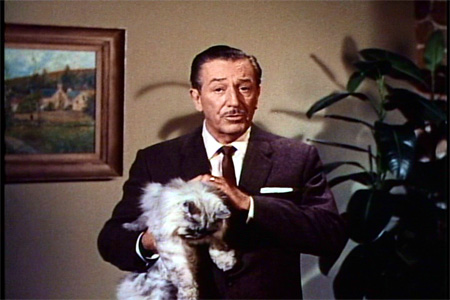
"I shall look forward to personally exterminating you, Mr. Bond."
The special features are all as fascinating as the main programs. The photo gallery is even worth looking through. There are some great shots from behind the scenes of 20,000 Leagues Under the Sea, plus stills of Walt with various dignitaries at Disneyland. Walt’s ability to transform even the most rigid personalities into children at heart is impressively on display.
"My Dad, Walt Disney" is a twenty minute interview with Diane Disney Miller. Maltin conducts the interview with a puppy dog’s sense of glee. Thankfully, he manages to overcome his adoration for her long enough to extract some great tidbits about growing up Disney. The long and short of it, she was one lucky little punk. The interview stays interesting throughout and provides a look at Walt’s private life. To compliment that interview, "Working with Walt," presents the impressions of Walt from former Mouseketeers and co-workers. The short segment doesn’t offer anything other than basic adoration for Walt from those lucky enough to grow up on the Disney back lot. It’s stunning to see that Tommy Sands still has insane hair at age 70.
Walt’s slick marketing abilities are on display in "I Captured the King of the Leprechauns." This forty-five minute program is nothing more than a glossy ad campaign for Darby O’Gill and the Little People. What separates this from any other marketing piece is the presence of Walt Disney and an accompanying story. The story finds Walt traveling to Ireland in search of the real king of the Leprechauns. Walt does a convincing job as an actor. It certainly helps that he’s playing himself. Strategically placed clips help to fill out the running time of the program. What’s amazing is that even for this cynic, the clips don’t give the impression of cold-hearted capitalistic synergy. It’s simply entertaining television that manages to smother its greedy intentions. How can one not be entertained when Sean Connery is seen belting out a little ditty?
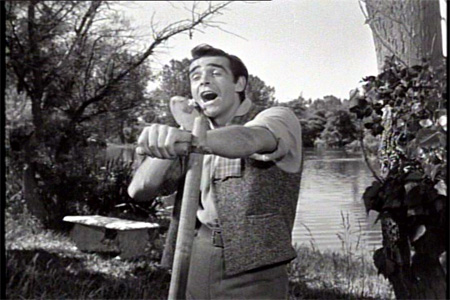
"Your Best," the showstopping number from The Rock: Alcatraztic!, was worth the price of a Sunday matinee.